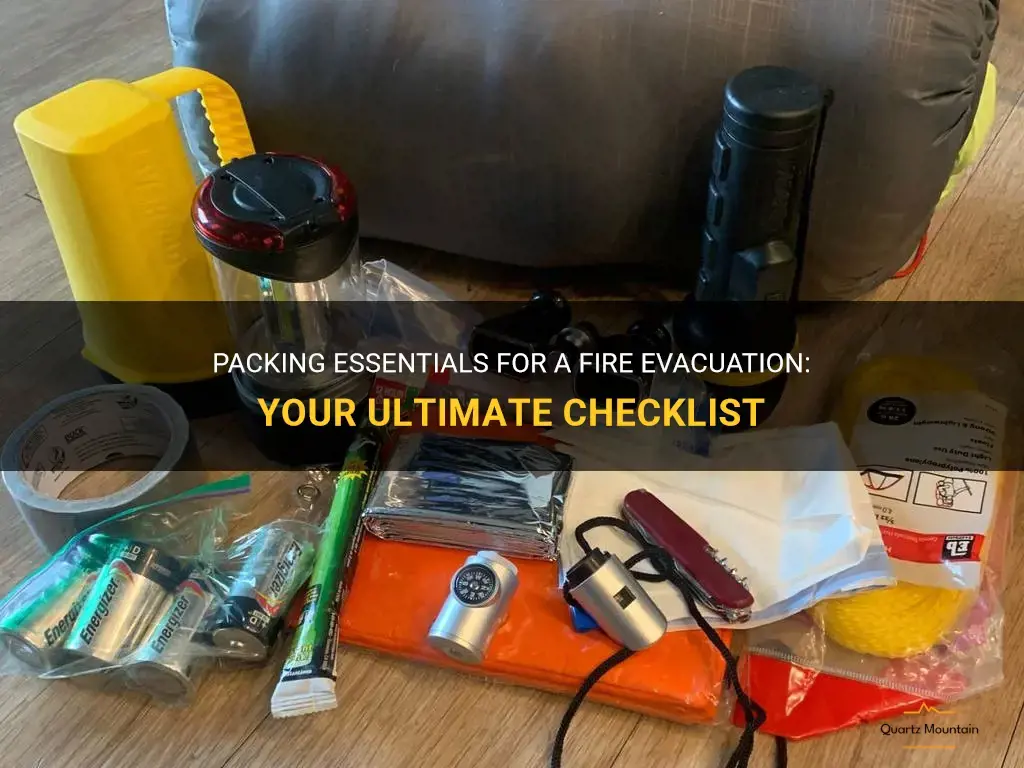
When it comes to being prepared for a fire evacuation, having the right packing essentials can make all the difference. Whether you're faced with a sudden wildfire or a mandatory evacuation order, having a well-thought-out checklist of items to grab can help ensure you have everything you need to stay safe and comfortable during this stressful time. From personal documents and medications to clothing and emergency supplies, this ultimate packing checklist will help you be prepared for whatever may come your way during a fire evacuation.
| Characteristics | Values |
|---|---|
| Personal identification | ID cards, passports |
| Important documents | Birth certificates, insurance papers, wills |
| Medications | Prescription medications, first aid kit |
| Clothing | Several changes of clothes, including warm layers |
| Food and water | Non-perishable food, bottled water |
| Toiletries | Toothbrush, toothpaste, toilet paper |
| Communication devices | Cell phone, charger |
| Cash | Small bills and coins |
| Comfort items | Blanket, pillow, favorite book or toy |
| Essentials for pets | Pet food, leash, carrier |
| Important keepsakes | Photos, jewelry, sentimental items |
| Emergency contact | List of emergency phone numbers |
| Maps and emergency plans | Maps of the area and emergency evacuation plans |
| Flashlight | Flashlight and extra batteries |
| Extra keys | House keys, car keys |
| Battery-powered radio | Battery-powered radio for emergency broadcasts |
| Personal hygiene items | Soap, hand sanitizer, feminine products |
| Change of shoes | Sturdy, comfortable shoes |
| Spare glasses or contacts | Extra pair of glasses or contacts |
| Spare phone battery | External battery for phone |
| Childcare supplies | Extra diapers, formula, baby food |
| Special needs items | Medical equipment, assistive devices |
| Rain gear | Rain jacket, hat, umbrella |
| Sleeping bag or mat | Sleeping bag or mat |
| Multi-tool | Swiss Army knife or similar tool |
| Whistle | Whistle to signal for help |
| First aid manual | First aid manual |
What You'll Learn
- When packing for a fire evacuation, what are the essential items that should be included in your emergency bag?
- Are there any specific items or documents that should be included in your emergency kit during a fire evacuation?
- What type of clothing and personal items should be packed for a fire evacuation?
- How much food and water should be packed for each person in case of a fire evacuation?
- Are there any additional items or supplies that should be considered when packing for a fire evacuation?

When packing for a fire evacuation, what are the essential items that should be included in your emergency bag?
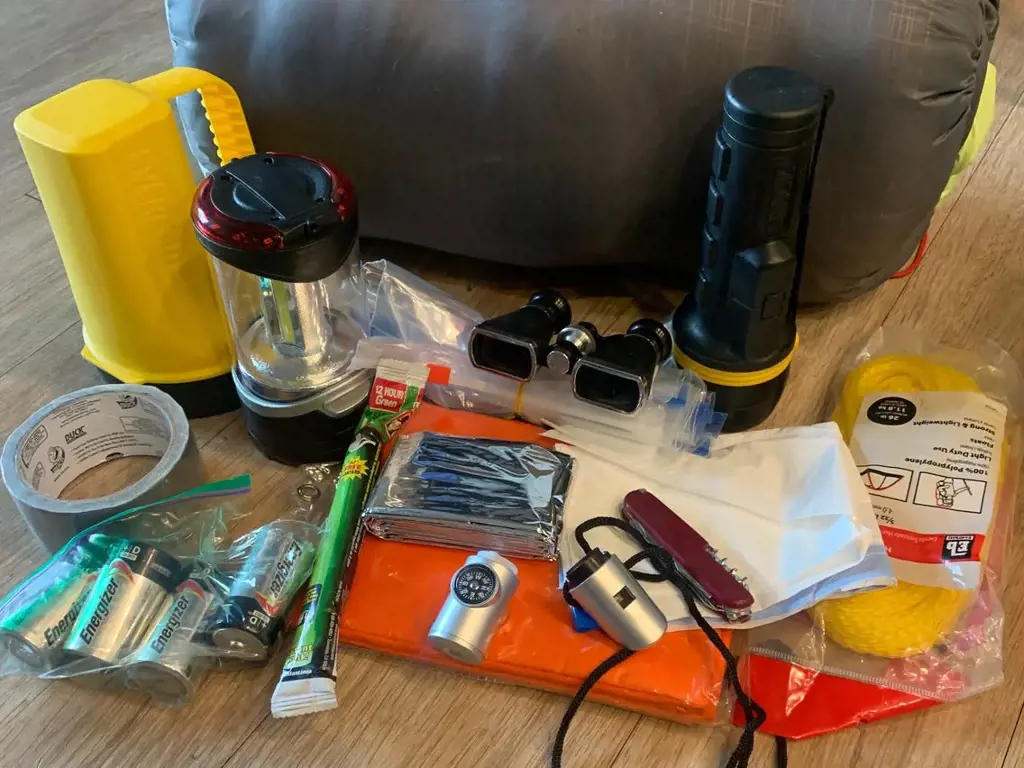
When faced with a fire evacuation, it is important to be prepared and have a well-stocked emergency bag. This bag should contain essential items that can help you stay safe and comfortable during the evacuation process. Here are some items that you should include in your emergency bag when packing for a fire evacuation:
- Important documents: Make sure to pack important documents such as identification cards, passports, birth certificates, insurance papers, and any other necessary legal documents. These documents are crucial and may be required during the evacuation process or when seeking assistance afterwards.
- Medications: If you or any members of your family take regular medications, be sure to pack a supply that will last for at least a few days. It's also a good idea to include a list of medications, dosages, and any allergies or medical conditions that you or your family members have. This information can be useful if you need medical assistance during the evacuation.
- First aid kit: A well-stocked first aid kit is essential during any emergency situation. Include bandages, antiseptic ointments, pain relievers, tweezers, scissors, and any other items that you may need to treat minor injuries. It's also a good idea to include any specific medications or medical equipment that you or your family may require.
- Emergency food and water: Pack non-perishable food items such as granola bars, canned goods, and dried fruits that have a long shelf life. You should also include a supply of bottled water to keep you hydrated during the evacuation. Aim for at least three days' worth of food and water per person.
- Clothing and personal hygiene items: Pack a change of clothes for each family member and be sure to include warm layers and sturdy shoes. Personal hygiene items such as toothbrushes, toothpaste, soap, and hand sanitizer should also be included in your emergency bag. These basic items will help you stay clean and comfortable during the evacuation.
- Emergency contact information: It is important to have a list of emergency contact numbers in case your phone's battery dies or you lose access to your phone. Include the contact numbers of local authorities, family members, and neighbors who can be of assistance during the evacuation.
- Cash and important valuables: It's a good idea to have some cash on hand in case ATM machines are inaccessible during the evacuation. You should also consider packing any important valuables such as jewelry, sentimental items, or irreplaceable documents that you can safely carry with you.
- Personal entertainment items: During a fire evacuation, you may find yourself waiting for extended periods of time. Including some personal entertainment items such as books, playing cards, or puzzles can help pass the time and distract from the stress of the situation.
When packing your emergency bag, try to keep it lightweight and easy to carry. Opt for a backpack or a duffle bag with sturdy handles. Additionally, periodically check the contents of your emergency bag to ensure that items such as medications and food have not expired.
Remember, when faced with a fire evacuation, safety is the top priority. Follow the instructions of local authorities and be prepared to leave your home quickly and safely. Having a well-stocked emergency bag can help make the evacuation process smoother and ensure that you have essential items to rely on during this challenging time.
The Essential Items Needed for a Trip to the Azores
You may want to see also

Are there any specific items or documents that should be included in your emergency kit during a fire evacuation?
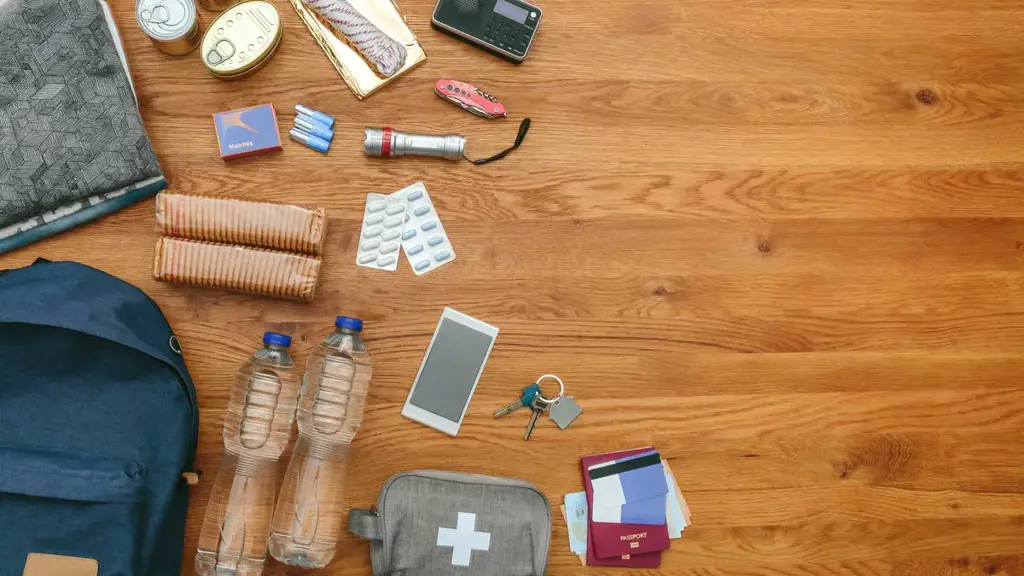
An emergency kit is an essential part of any fire evacuation plan. It contains items and documents that are needed to ensure your safety and well-being during a fire emergency. While the specific contents of an emergency kit may vary based on individual needs and circumstances, there are some items and documents that should be included in every kit.
- Important Documents: It is crucial to have copies of important documents readily available in case of a fire evacuation. These documents should include identification papers, passports, birth certificates, marriage certificates, financial records, insurance policies, wills, and any other legal documents that may be difficult to replace. Store these documents in a fireproof and waterproof container, or make digital copies and store them on a portable flash drive or cloud storage.
- First Aid Kit: A well-stocked first aid kit is essential for any emergency situation, including a fire evacuation. It should include bandages, antiseptic ointment, gauze pads, adhesive tape, scissors, tweezers, disposable gloves, and any prescribed medications. Additionally, it is advisable to include a basic first aid manual to assist in administering first aid if needed.
- Emergency Contacts: Make a list of emergency contacts and keep it in your emergency kit. Include the phone numbers of family members, neighbors, friends, doctors, and emergency services. It is also a good idea to have a laminated card with important phone numbers in case your phone is not functional during the evacuation.
- Portable Phone Charger: During a fire evacuation, power outages or depleted phone batteries can become a problem. Having a portable phone charger or a fully charged power bank can help ensure that you have access to communication and emergency updates.
- Flashlight and Batteries: In the event of a fire evacuation, there may be darkness or power outages. A flashlight with extra batteries is essential for navigating through potentially hazardous situations, such as dark hallways or stairwells.
- Cash and Credit Cards: In an emergency situation, access to money is essential. Keep a small amount of cash and some credit cards in your emergency kit. This can help cover immediate expenses such as food, transportation, or temporary accommodations until normalcy is restored.
- Spare Clothing and Comfort Items: A fire evacuation could mean staying away from home for an extended period. Pack a change of clothes, including sturdy shoes and comfortable clothes suitable for the weather conditions. Additionally, consider including comfort items like a blanket, pillow, or favorite stuffed animal for children, as it can provide a sense of security during a stressful situation.
- Non-Perishable Food and Water: It is important to have a supply of non-perishable food and bottled water in your emergency kit. Pack enough food for at least three days, including items such as canned food, energy bars, and dried fruit. Don't forget to pack a manual can opener.
- Personal Hygiene Items: Include essential personal hygiene items such as toothbrushes, toothpaste, soap, hand sanitizer, feminine hygiene products, and toilet paper. These items will help maintain personal hygiene and cleanliness during the evacuation period.
- Entertainment and Personal Items: To help alleviate stress and anxiety during a fire evacuation, it is advisable to include entertainment items such as books, playing cards, puzzles, or small toys for children. Also, consider including sentimental or irreplaceable personal items that hold great value or importance to you and your family.
Remember, when creating your emergency kit, customize it to your personal needs and circumstances. Consider factors such as family size, specific medical requirements, and any special needs of household members. Regularly check and refresh your emergency kit to ensure that all items are up to date, functional, and appropriate for the season.
Essential Items to Pack for a Successful Rehab Journey
You may want to see also

What type of clothing and personal items should be packed for a fire evacuation?
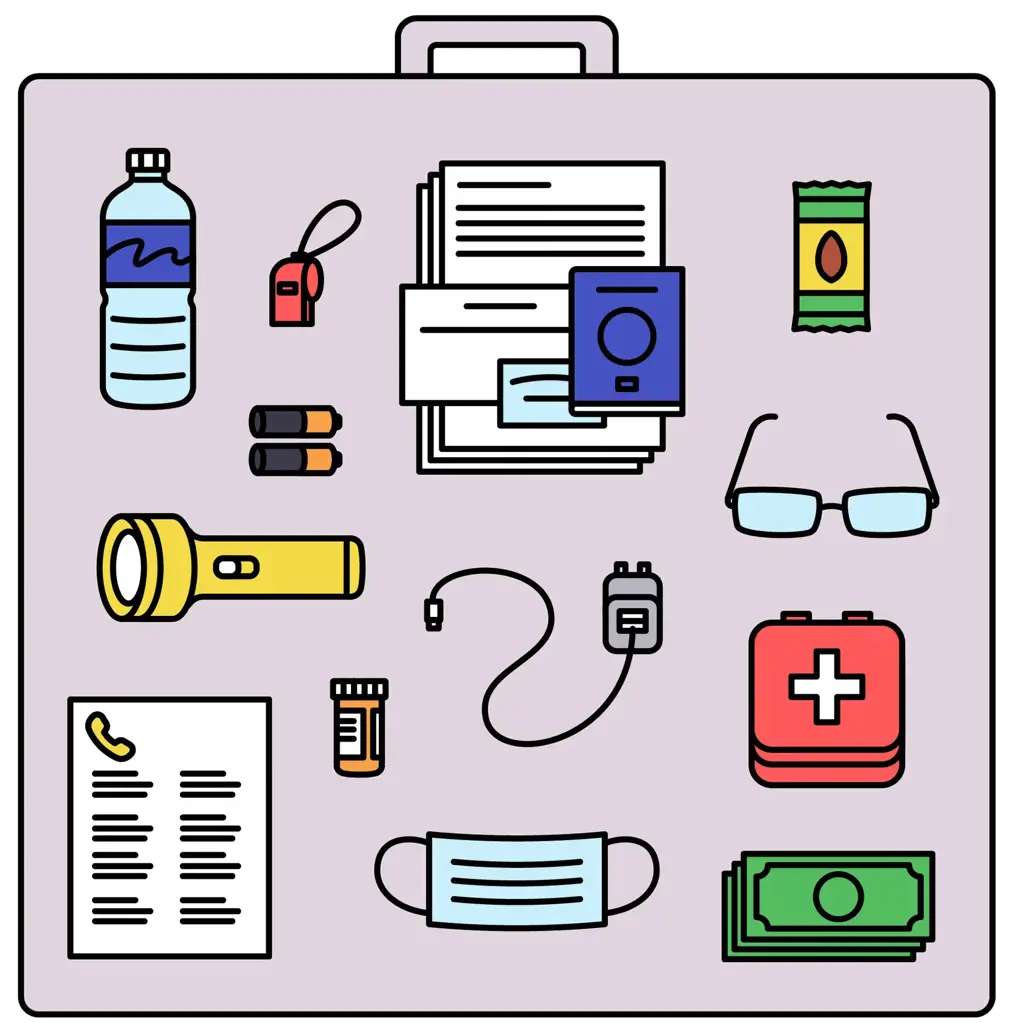
When faced with the threat of a fire evacuation, it is crucial to pack essential clothing and personal items that will ensure your safety and comfort throughout the ordeal. While the specific items may vary depending on the location and individual needs, there are some general guidelines to follow.
Protective Clothing:
It is important to pack clothing that offers protection from the heat and smoke. Opt for long-sleeved shirts, long pants, and closed-toe shoes to minimize exposure to embers or other hazards. Choose lightweight, breathable fabrics such as cotton or linen to ensure comfort in potentially high temperatures.
Outerwear:
Pack a sturdy jacket or coat to shield yourself from the cold if the fire evacuation happens during winter or in colder regions. Consider a waterproof option to protect you from rain or potential dousing during firefighting efforts.
Personal Protective Equipment (PPE):
Include personal protective equipment such as gloves and goggles to safeguard yourself from potential debris or smoke-related irritants. This PPE can be vital, especially when navigating through areas affected by the fire.
Personal Identification and Documents:
Carry important documents, such as identification cards, passports, and insurance papers, in a waterproof and fireproof container. These documents are crucial for identification purposes, accessing resources, and filing insurance claims.
Prescription Medications and Medical Supplies:
If you have any pre-existing medical conditions, ensure you pack an ample supply of prescription medications. Include any necessary medical supplies or equipment, such as inhalers or glucose meters, as well.
Hygiene and Sanitary Supplies:
Pack a small toiletry bag containing personal hygiene items such as toothbrushes, toothpaste, soap, and toilet paper. Having these essential supplies can help maintain personal hygiene during the evacuation period, whether in temporary shelters or on the move.
Emergency Food and Water:
Include non-perishable food items that require minimal preparation, such as protein bars, canned goods, or dried fruits. Be sure to pack a sufficient amount of bottled water to stay hydrated during the evacuation, as access to clean water may be limited.
Clothing for Multiple Days:
Pack enough clothing for at least a few days, considering the duration of the evacuation and any potential delays in returning home. Be mindful of the weather conditions and ensure you have appropriate clothing for both warm and cold temperatures.
Comfort Items:
Include comfort items such as a small blanket, a favorite book, or a portable charger for electronic devices. These items can provide a sense of familiarity and comfort during the stressful period of evacuation.
Cash and Credit Cards:
Carrying cash and credit cards is essential for emergency situations. Prepare by keeping a small amount of cash on hand and ensuring your credit cards are readily accessible.
Fire evacuations are often unexpected, and it is vital to be prepared beforehand. Develop a personalized evacuation checklist based on your family's needs, location, and potential risks. Consider the unique requirements of elderly family members, young children, or individuals with disabilities. Regularly review and update the contents of your evacuation kit to ensure everything remains current and in working condition.
Remember that personal safety is the top priority during a fire evacuation. Ensure you have a clear evacuation plan and follow the instructions of local authorities.
The Essential Clothing Packing Guide for a Vacation in Sebastian, Florida
You may want to see also

How much food and water should be packed for each person in case of a fire evacuation?
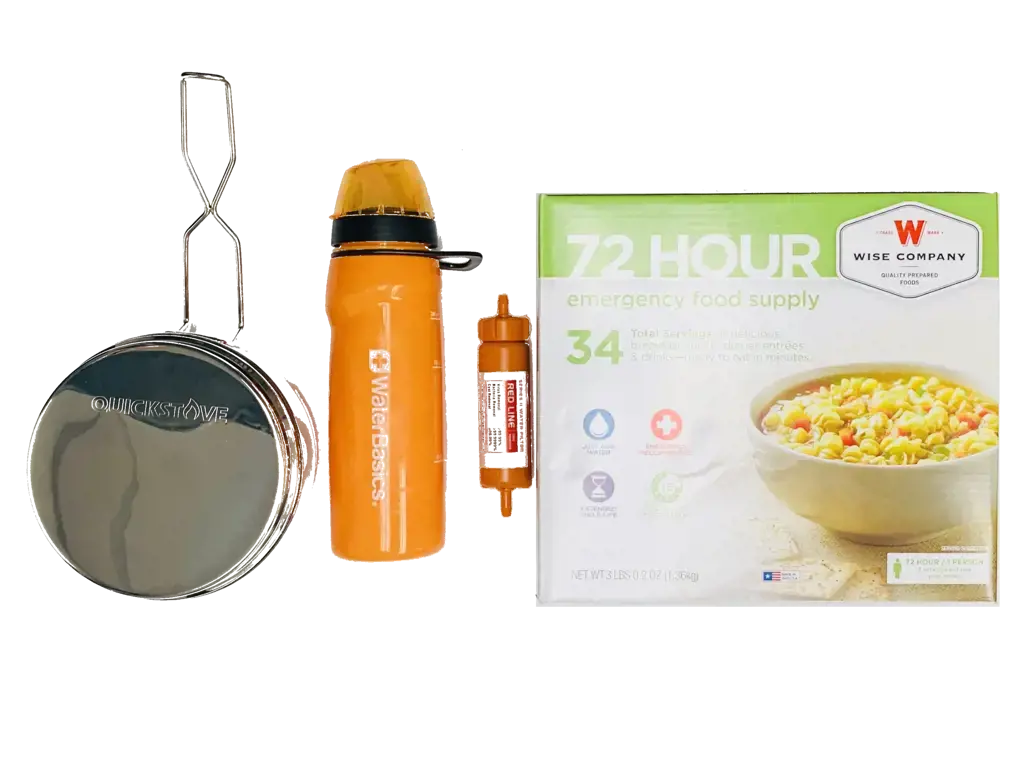
When it comes to preparing for a fire evacuation, it is important to have a well-stocked emergency supply kit that includes enough food and water for each person in your household. In the event of a fire emergency, access to clean water and nutritious food may be limited, so it is crucial to pack enough supplies to sustain yourself and your family until help arrives or it is safe to return home.
The recommended amount of water to pack for each person is one gallon per day. This includes both drinking water and water for hygiene purposes. Depending on the length of the evacuation, it is advisable to pack at least a three-day supply of water per person. This means that for a family of four people, you should have at least twelve gallons of water on hand.
When it comes to packing food, it is important to choose non-perishable items that do not require refrigeration and can be easily consumed without cooking. Some examples of suitable emergency food items include canned goods, granola bars, peanut butter, jerky, and dried fruits. Aim to pack enough food to provide each person with a minimum of 2,000 calories per day. This will ensure that everyone in your family receives the necessary nutrients and energy to keep them sustained during the evacuation.
In addition to food and water, it is also advisable to pack necessary utensils, such as plastic cutlery, plates, and cups. These items will come in handy when you need to consume your emergency rations. It is also a good idea to include a manual can opener, as many emergency food items come in cans that cannot be opened without one.
When packing your emergency supplies, make sure to consider any specific dietary restrictions or allergies that your family members may have. It is always better to be prepared and have alternative options available for those with special dietary needs.
Lastly, it is essential to periodically check and rotate the items in your emergency supply kit. This will ensure that the food and water remain fresh and safe to consume in the event of an evacuation. Make it a habit to check the expiration dates of your canned goods and replace them if needed. Additionally, rotate your water supply every six months to ensure its quality and avoid any contamination.
In conclusion, it is crucial to pack enough food and water for each person in case of a fire evacuation. Aim to have at least a three-day supply of water, providing one gallon per person per day. Pack non-perishable food items that can be easily consumed without cooking and aim for a minimum of 2,000 calories per person per day. Consider any dietary restrictions or allergies and include necessary utensils. Lastly, regularly check and rotate your emergency supplies to ensure their freshness and safety. By taking these steps, you can ensure that you and your family are prepared for any fire evacuation situation.
Essential Items to Pack for a Memorable Vacation to Florida: A Comprehensive Checklist
You may want to see also

Are there any additional items or supplies that should be considered when packing for a fire evacuation?
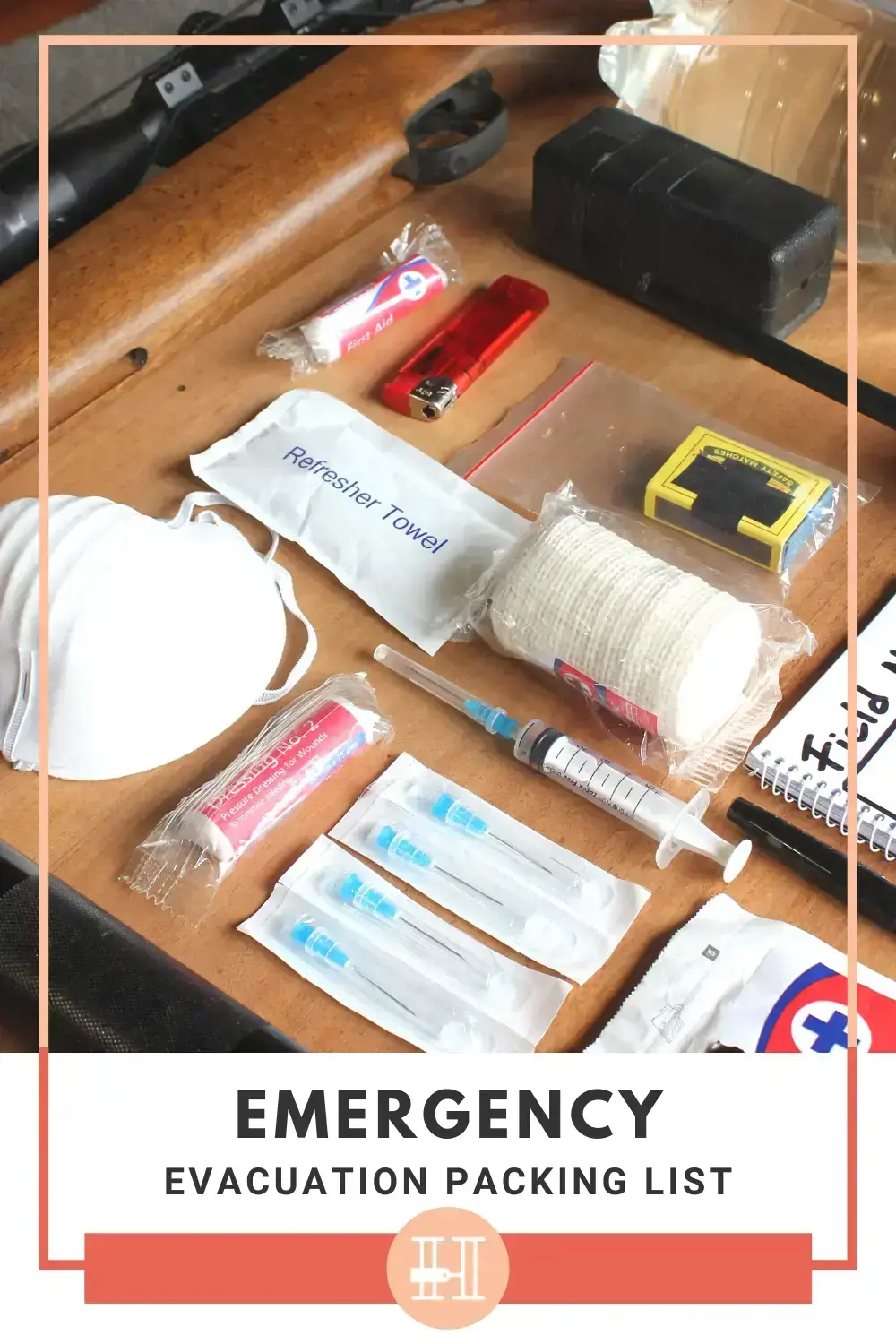
When packing for a fire evacuation, it is important to consider not only the essentials but also any additional items or supplies that can enhance your safety and comfort during the evacuation process. Here are some things you should consider including in your evacuation pack:
- Fireproof Document Bag: It is crucial to have a fireproof document bag to store important documents such as identification cards, birth certificates, insurance policies, and any other valuable paperwork. This will protect them from being damaged or destroyed during a fire.
- Extra Medication: If you or any family members have ongoing medical conditions, make sure to pack extra medication in your evacuation bag. During a fire evacuation, it may be difficult or even impossible to access pharmacies or healthcare facilities, so having extra medication on hand is essential.
- First Aid Kit: A well-stocked first aid kit is crucial during an evacuation. It should contain basic supplies such as bandages, antiseptic wipes, pain relievers, and any necessary prescription medications. Additionally, include a first aid manual that outlines basic medical procedures and instructions.
- Emergency Cash: During a fire evacuation, ATMs and bank services may be unavailable. It is advisable to have some emergency cash on hand to cover immediate expenses such as food, transportation, and accommodation. Make sure to keep the cash in a waterproof and secure container.
- Portable Phone Charger: Having a portable phone charger can be a lifesaver during an evacuation, especially if power outages occur. Ensure that the charger is fully charged before the evacuation and consider investing in a high-capacity charger that can provide multiple charges.
- Emergency Whistle: An emergency whistle can be a valuable tool to attract attention and signal for help during an evacuation. It is easy to carry and can be used to alert others to your location, especially in situations where visibility is low or communication is limited.
- Personal Protective Equipment: Include personal protective equipment such as dust masks, goggles, and gloves to protect yourself from smoke, debris, or other hazards that may be present during a fire evacuation. These items can help prevent respiratory issues and eye injuries.
- Emergency Food and Water: Pack non-perishable food items such as granola bars, canned goods, and sealed snacks. Include a sufficient supply of drinking water, aiming for at least one gallon per person per day. Remember to periodically check and replace expired food and water to ensure freshness.
- Change of Clothes: It is essential to pack a change of clothes for each family member. Choose breathable and comfortable clothing suitable for the current weather conditions. Also, consider packing sturdy shoes or boots and rain gear to protect against potential inclement weather.
- Personal Hygiene Supplies: Don't forget to include personal hygiene items such as toilet paper, wet wipes, hand sanitizer, toothbrushes, toothpaste, and feminine hygiene products. These essentials will help maintain cleanliness and hygiene during the evacuation period.
- Important Contacts: Keep a list of important contact information, including emergency services, family members, friends, and neighbors. Include phone numbers, email addresses, and physical addresses. Having this information readily available can help you stay connected and informed during the evacuation.
While each person's needs may vary, these additional items and supplies should be considered as part of a comprehensive fire evacuation plan. Keep your evacuation pack in a readily accessible location, regularly review and update its contents, and ensure that all family members are aware of its location. Being prepared can make all the difference in ensuring your safety and well-being during a fire evacuation.
Essential Items to Pack in Your Diaper Bag for a Flight
You may want to see also
Frequently asked questions
During a fire evacuation, it is important to pack essential items that will help you survive for at least 72 hours. These items include a first aid kit, non-perishable food, water, a flashlight, batteries, a radio, toiletries, important documents (such as identification and insurance papers), a change of clothes, a blanket or sleeping bag, and any necessary medications.
While it is tempting to pack sentimental items, such as photo albums or heirlooms, it is recommended to prioritize essential items that will help ensure your safety and well-being during a fire evacuation. Sentimental items can be easily replaced or stored in a secure location, reducing the risk of loss or damage during an emergency situation.
It is recommended to pack at least one gallon of water per person per day during a fire evacuation. This will ensure an adequate supply of drinking and cooking water for each individual for a three-day period. If you have pets, remember to pack additional water for them as well.
Yes, it is a good idea to bring some cash with you during a fire evacuation. In the event of power outages or limited access to electronic payment systems, having cash on hand can be helpful for purchasing necessary supplies or services. It is recommended to have a mix of small bills and coins, as well as some larger denominations for emergencies.







